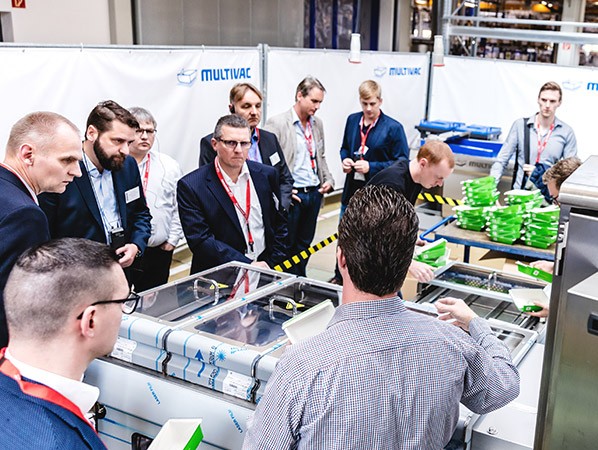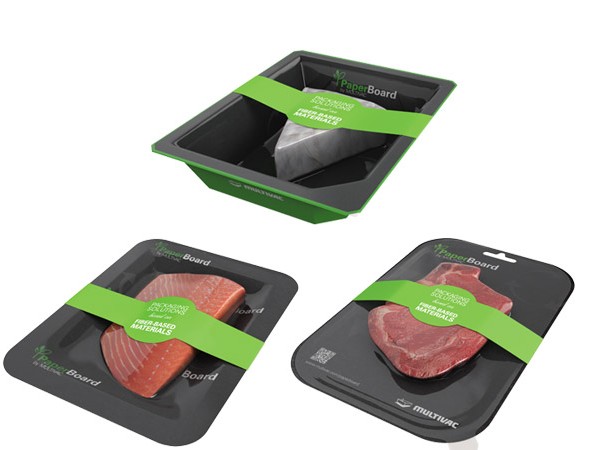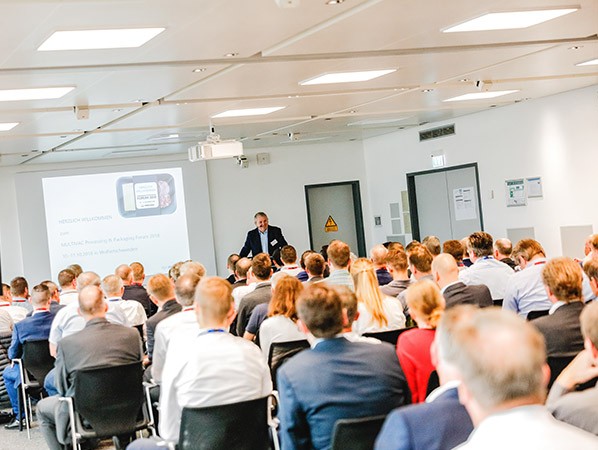
Sustainable packaging is a theme that can no longer be discarded. It is what consumers want, the retail demands it from its suppliers, and for food manufacturers it fits within their vision on corporate social responsibility. This is why MULTIVAC accepts its responsibility as well. It has set itself the task to develop sustainable packaging and to inform and support its business relations towards the transformation to sustainable packaging.
In October, MULTIVAC hosted its first two-day 'Processing and Packaging Forum', which took place at the headquarters in Wolfertschwenden. More than 80 representatives from the food industry, from Germany, Austria, Switzerland, and the Benelux countries, gathered here to be informed and to engage in dialogues about subjects such as packaging trends in the food industry, innovative slicing solutions, and the problems in international trade.
Hans-Joachim Boekstegers, Managing Director and CEO of the MULTIVAC Group, stated that doing business outside the EU is becoming increasingly difficult: "We already feel the consequences of Brexit, and the destabilisation in Turkey and increasing nationalistic sentiments in Italy and Poland result in a challenging trade climate. The negative effect of Trump's politics on the global trade, based on the protectionism of the United States will, sooner or later, disadvantage our economy as well. Whoever conducts business with the US, has to take the embargoes against Russia, China, and Iran into account and carefully contemplate the own position in this. And then we are not even mentioning the dangers the upcoming economies such as Argentina, Brazil, and Northern and South Africa can pose".
During the interactive forum, the themes were subdivided into e-commerce and automation and digitisation. A lot of attention was given to the new packaging legislation (VerpackG) which will become effective in Germany on 1 January 2019. Combined with the European Strategy for plastics (which kicked off in January 2018), the law has to counter the enormous global increase in the production and use of plastic. Its purpose is the introduction of a recycling economy for manufacturers of plastics and to stimulate them to use more eco-friendly packaging. The law applies to all distributors who put packaging on the German market. No exceptions are made for small companies; according to this law, anyone who puts packaging on the market in Germany has to register and conclude a contract in terms of a so-called 'dual system'. This means that the law is not only applicable to national products but also to all importers and online tradesmen who bring goods onto the German market; also from the Netherlands. The deciding factor for the choice of the packaging material will be the way the recycling cycles are structured. At the moment, this is only the case for materials based on fibres and cellulose.
A reduced use of packaging material and an improved recyclability will result in more eco-friendly and sustainable packaging. Producing packaging from renewable sources and biodegradable or recyclable materials is one way to achieve this. Nevertheless, the EU strategy for plastics is mostly focusing on the recycling of plastics at the end of their life cycle. The total footprint is not sufficiently taken into account. Another difficulty is the fact that there is still no uniform definition of 'recyclable'. This is why there was such a broad interest in the packaging solutions based on paper and paper composites such as MULTIVAC PaperBoard. This packaging concept can already be used to implement MAP and skin packs based on paper fibre on thermoformers and traysealers. With the combination of modules for loading and unloading and for labelling, there are now fully automated packaging solutions that comply with the efficiency requirements. Both the paper composite and the paper back (to which a striking print can be added!) are recyclable. The carrier material is processed as a rolling material or cut to size, but prefabricated trays are also used.

The presentation of a packaging in the form of carton trays was a first for the participants. For the live demonstration on the R 245 thermoforming packaging machine, MULTIVAC used mono carton trays (for traysealers, carton composite trays are used). In the thermoforming mould, the inside of the trays is given a suitable plastic film sealing layer, after which they are filled with the products and sealed with a top film. Both layers of film can be easily removed and thrown away with the plastic waste. The paper carrier can be thrown out with the paper waste. The participants were all enormously interested in this concept.
The food processing industry must be able to respond quickly to the changing demand from the market and, subsequently, to the demands of the trade in general. More and more fresh and processed food products, snacks, ready-made meals, portion packages, and ready-made products are produced and packaged. This means that the manufacturing companies need to increase their efficiency across the whole process chain: the proper collection of all relevant process data and the linking of machines to ERP systems. The services provided by MULTIVAC 'Smart Services, such as condition monitoring, predictive maintenance, remote assistance, augmented reality, and the preparing of extensive OEE analyses, will contribute significantly to the upscaling of the availability of machines and, consequently, to the efficiency. With the launch of the Cutting Solutions Division, MULTIVAC recently took an important, strategic step in order to offer integrated, comprehensive solutions to its clients around the world. Hans-Joachim Boekstegers explained that they have also just started building a competence centre for slicing and automation solutions in Wolfertschwenden. This centre is scheduled to be completed in 2020.
One example of such a total solution that increases the efficiency is the line with the S 800 Slicer, a horizontal loader with buffer function, and the R 235 thermoforming machine. Compared with conventional solutions currently on the market, this line has a substantially smaller CO2 footprint. During the forum, the participants could see a demonstration of this line. The line first sliced and packaged cheese, directly followed by the Bavarian Leberkäse. "The S 800 can handle nearly all slicing jobs. The key elements of the slicer are the knives and the slicing technology", explains one of the MULTIVAC employees. "The products are first precisely and carefully sliced and perfectly aligned to the centre of the cutting glasses. The positions for the product grippers are specified for all applications. The grippers can be very quickly removed or placed. Changing the cutting glasses and knives is also easy; no extra tools are required. The horizontal loader prevents differences in height between the slicing machine and the packaging machine, and the length of the line has been considerably reduced. "Thanks to a quick-change system, the R 235 thermoforming packaging machine is very flexible when it comes to the packaging material, cuts, and sizes", the employee further explains. "Even untrained personnel can operate the full functionality of the machine or line with one finger."
"We are very happy with the positive reactions during our forum", says Dr Jens Müller, Managing Director of MULTIVAC Germany. "An interactive event allows us to respond directly to topical questions and challenges from our clients and to come with possible solutions. This is very much appreciated." This was also evident from the enthusiastic reactions from the participants, who went home with a lot of essential information.

There are multiple ways in which PaperBoard can be used in the production process
Digitisation: more opportunities than risks!
-How can I upgrade the control on my line?
-How is the machine linked to the ERP system?
-As an operator of the packaging line, what can I read and interpret from my data?
-How can I optimise my packaging process or increase the efficiency?
-What will happen with my data? Is my data absolutely secure?
E-commerce: B2C or do I stay with B2B?
-What are the main obstacles and problems of online food distribution?
-What is the effect on the processes when I receive more and more B2C applications?
-Will this result in specific requirements for the packaging?
-How can I personalise products and switch to single-serve sizes?
-Regarding the consumer, e-commerce only works with unique products!
Automation: which criteria are determining the packaging process?
-Savings on personnel costs.
-It’s difficult or impossible to find good employees.
-Hygiene improvements.
-Increasing the production volume, efficiency, and process reliability.
-Product safety and shelf life of products.
Automation: why have certain processes not (yet) been automated?
-Costs.
-Missing interfaces, different components, which means missing line management.
-The packaging process is too flexible due to the multitude of variants.
-Compared to manual solutions, automation requires more space.
-Specific features and lack of standardisation in products.
Source: © Multivac